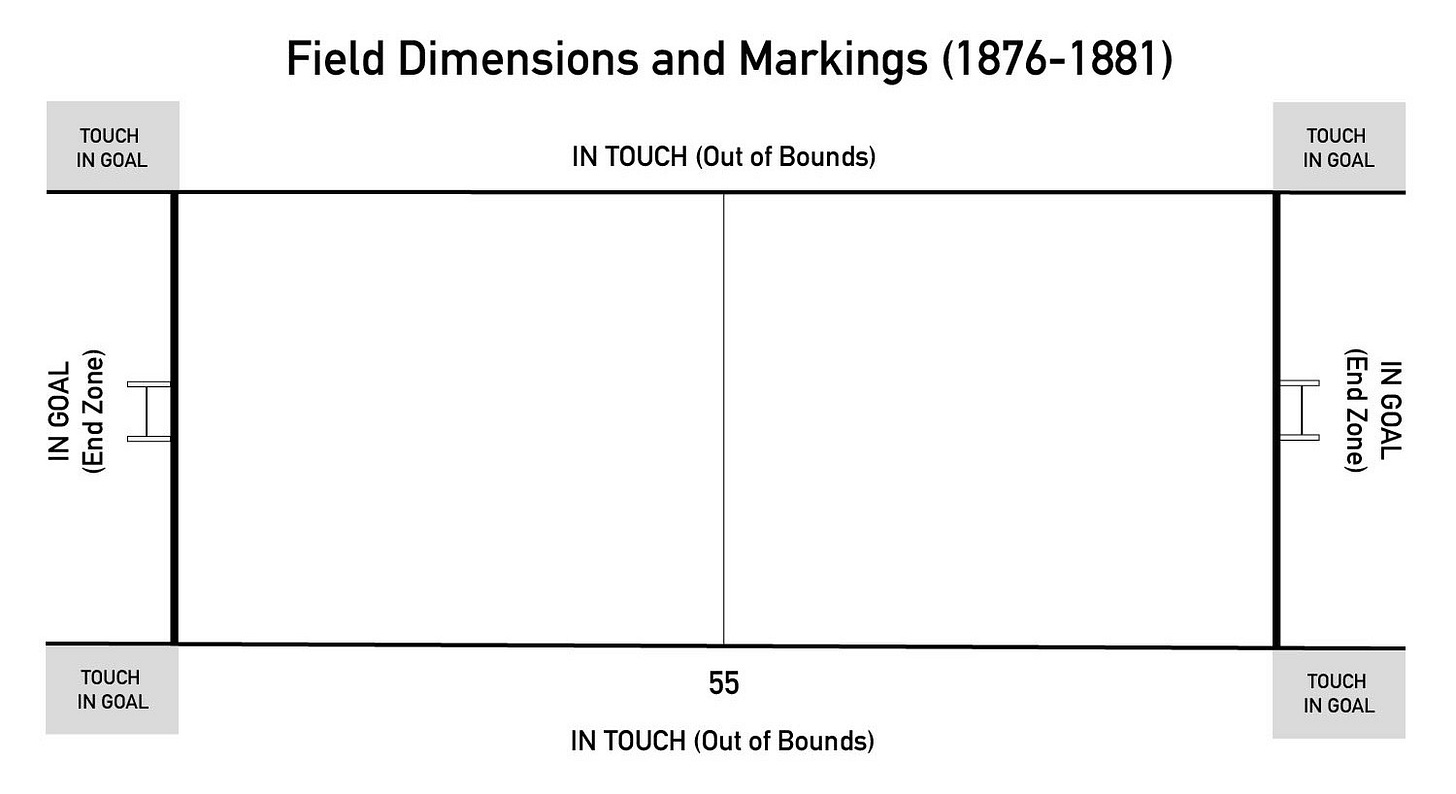Today's Tidbit... 1876 IFA Rule #60: The Field
This is #60 in a series covering football's original 61 rules adopted by the Intercollegiate Football Association in 1876. We review one rule each Friday.
The old folk football games kicked the ball from one town center to the next or defined the pitch based on what was available at a local park or field. As rugby developed at Rugby School, they played the game on a field known as Old Bigside, which was about 130 by 80 yards. As the rugby version of football spread to other locations, they played on fields of reasonably similar dimensions until 1879, when the Rugby Union rule-makers amended the rules to define a maximum field size:
The field of play must not exceed 110 yards in length, nor 75 yards in breadth, and should be as near those dimensions as practicable.

Since the Canadian game followed the Rugby Union rules at the time, they also did not have a defined field size when the IFA established football’s first rules in 1876. The Rugby Union and Canadian rules stopped at #59. However, the Americans, who had used the Public Land Survey System since 1796 to plat the lands west of the Ohio River into orderly sections and quarter sections, added:
Rule 60: The grounds shall be 140 yards long and 70 yards wide.
The rule did not specify a midfield stripe, but a proper field had one and two goal lines 70 yards distant. The field was also 70 yards wide. Some early fields lacked stripes, with pennants in the four corners defining the boundaries, much like trees, fence posts, streetlights, or front bumpers served the same purpose in kids’ games on and down the road.
The IFA reduced the field length and breadth in 1882 to 110 yards by 160 feet (53 1/3 yards). The field changed for a second time in 1912 when the 55-yard line disappeared, and two 10-yard end zones were attached to the goal lines.
Meanwhile, the Canadian Rugby Union standardized the field at its current size of 110 by 65 yards by 1884 or earlier. Like the American field, the Canadian field did not have end zones, but it had similar areas of indeterminate depth beyond the goal lines. They limited their goal area (aka end zone) to 25 yards and reduced it to 20 in 1986. (Please advise if anyone has a citation for when Canada formalized the depth of the goal area (end zone)).
Having reviewed 60 of the 61 original rules, we have nearly reached the end of a journey that started last October. Rule 61, which defines the number of players per side, will be reviewed next Friday, followed on the 22nd with a summary of a few things learned along the way.
We’ll see you for the grand finale next week!
Click the appropriate link for previous stories in the series:
Intro | #1 Drop Kick | #2 Place Kick | #3 Punt | #4 Goal Posts | #5 Goal | #6 Goal ≠ Punt | #7 Scoring | #8 Dead Ball | #9 Touchdown | #10 Tackle | #11 Scrimmage | #12 Ball Handling | #13 Dead Ball | #14 Scrimmage Ball Handling | #15 Run In | #16 Goal Line | #17 Boundary Lines | #18 Crying “Down” | #19 Maul In | #20 Maul in Pax | #21 Touch-in Goal | #22 Onside | #23 Offside | #24 Return to Onside | #25 Defensive Offside | #26 Throwing Back | #27 Knocking On | #28 Fair Catch | #29 Punt-out | #30 Punt-On | #31 Into Touch | #32 Inbounding | #33 Pushed Into Touch | #34 Right Angle Throw Out | #35 No Fair Catch | #36 Kickoff | #37 Kickoff Timing | #38 Change Goals | #39 Toss Up | #40 Loser Kicks | #41 Kickout | #42 Kickout Procedure | #43 Fair Catch Free Kick | #44 Free Kick Location | #45 Own Goal Touch Down | #46 Try At Goal | #47 Try At Goal Spot | #48 Touched Down Between Posts | #49 Puntout Spot | #50 Heel-In Mark | #51 No Fair Catch OOB | #52 TD Interference | #53 Missed Kicks | #54 Charging | #55 Charge At Once | #56 Charging Locations | #57 Hacking | #58 Gutta Percha | #59 Officials
Football Archaeology is reader-supported. Click here to buy one of my books or otherwise support the site.


